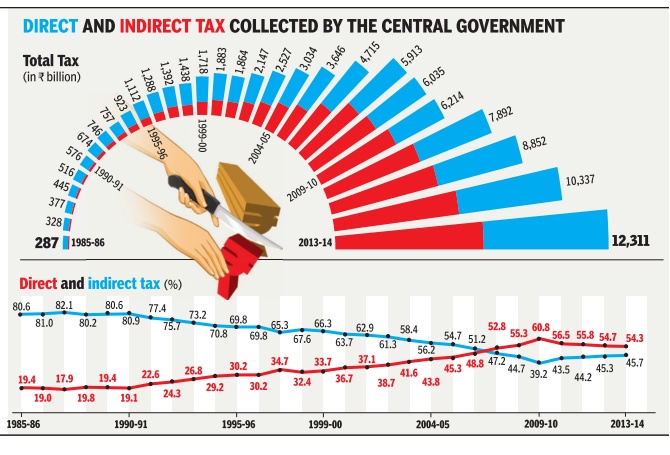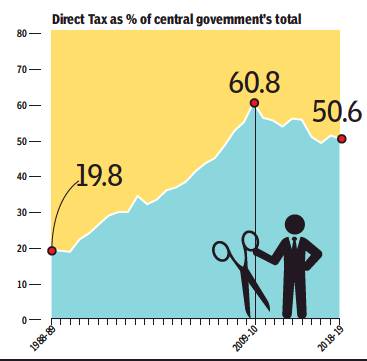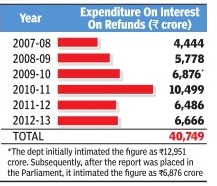Direct taxes: India
This is a collection of articles archived for the excellence of their content.
|
Contents |
Interest liability on tax refunds
CAG pulls up finmin on tax refunds
New Delhi: TIMES NEWS NETWORK
The Times of India Aug 05 2014
Auditor Says I-T Department Refunded Rs6,700Cr Without House Nod
The finance ministry has been pulled up by the Comptroller & Auditor General (CAG) for making tax refunds of close to Rs 6,700 crore without Parliamentary authorization.
In its latest report, tabled in Parliament last week, CAG said, the Public Accounts Committee too had concurred with it and pointed out that “there was no valid ground as to why the department (of revenue) could not make broad estimates of expenditure on interest liability on tax refunds based on the studied trends of the past“.
It also said that the revenue department itself had admitted that in terms of Article 266 of the Constitution, it had no legal authority to withdraw the ‘interest' on excess tax collected and make refunds without getting it approved by Parliament.
Apart from CAG, even experts have argued that in the interest of transparency , the government should not hold back tax refunds and explicitly provide for it in the Budget.
But the finance ministry has refused to heed to this plea. has refused to heed to this plea. Typically, to meet the stiff tax targets set by the finance minister, tax officials push companies to cough up higher taxes, which are then refunded. The department also goes slow on refunds to ensure that the overall tax collection number looks healthy. Usually, the government has refunds of around Rs 1 lakh crore at the start of the financial year.
In fact, last year, the issue was also referred to the attorney general G E Vahanvati, who initially suggested that the CAG was right but later gave a different opinion when more facts were presented to him. Vahanvati and Sumit facts were presented to him. Vahanvati and Sumit Bose, then revenue secretary , had been summoned to the PAC for what it believed were “mutually contradictory opinions“ on the expenditure that the government incurred in paying interest on tax refunds.
In its latest report, CAG has said that over the last six years, Central Board of Direct Taxes alone had made refunds of close to Rs 41,000 crore, without obtaining legislative approval. A similar practice is also followed on the indirect taxes front, although on a smaller scale. According to CAG's estimates, over the past four years, refund of indirect taxes added up to nearly Rs 45 crore.

Apr 22 2015
Unlike direct taxes like income tax which are paid only by the relatively well-off, whether an individual or a company, indirect taxes like sales tax, VAT, service tax are paid by everyone irrespective of their income levels. This is why higher collections of direct taxes are seen as a sign of a `progressive' tax regime. Data on the central government's tax revenues shows that from 1990-91 to 2009-10, the share of direct taxes in total tax revenue witnessed a steady increase. Since 2009-10, however, this share has been declining largely due to service tax emerging as a major source of revenue Research: Atul Thakur; Graphic: Sunil Singh; Source: Reserve Bank of India 1
Widening the direct taxpayer base
1988-2018
June 25, 2019: The Times of India

From: June 25, 2019: The Times of India
India’s taxation has become more poor-friendly after Liberalisation
Thirty years ago, less than 20% of the Centre’s tax revenue came from income tax and other direct taxes. More than 80% came from indirect taxes like custom and excise duties that the rich and the poor pay equally on purchase of goods and services. Today, direct taxes that are imposed on the country’s relatively well-off population account for more than half of the Centre’s total tax revenue
2013-2016
Direct taxpayer base growth slows in Modi govt’s first 2 yrs, December 21, 2017: The Times of India

ii) Direct tax-GDP ratio, FY13-16
From: Direct taxpayer base growth slows in Modi govt’s first 2 yrs, December 21, 2017: The Times of India
See graphic:
i) Increase in direct taxpayers, FY13-FY16
ii) Direct tax-GDP ratio, FY13-16
Hopes For Widening Net Alive With 91L Added After Note Ban
Tax concessions and moderate increments have slowed down the expansion of direct taxpayer base in the first two years of the Narendra Modi government, a trend that it expects to reverse post-demonetisation.
Data released by the tax department showed that the number of individual taxpayers filing returns has grown, but at a slower pace for four years in a row starting 2012-13, when there was an increase of 54 lakh. But ever since then, the numbers will not bring cheer as far as widening the base is concerned. In fact, in the first two years of the current regime, the number of individual taxpayers rose from 5.4 crore in 2013-14, the year before Modi swept to power, to 5.93 crore in 2015-16 — an increase of 53 lakh.
But with at least 91lakh taxpayers added-post demonetisation, the government is hoping to significantly widen the base.
Tax experts say part of the reason for the moderation in growth in the direct taxpayer base are the concessions offered by the Modi government.
For instance, in his first Budget after the elections, finance minister Arun Jaitley had increased personal income tax exemption limit by Rs 50,000, which was seen as a reward for the middle class. This move is seen to have pushed several individuals out of the net. In 2015, he followed it up with more deductions for health insurance and pension.
“The reduction in individual taxpayers could be a consequence of increase in basic ceiling of taxable income for individual taxpayers in 2014-15. The data of 2015-16 is prior to demonetisation — it not only has carry-over effect of reduction in basic taxable income but also marginal increase in income of salaried class,” said Samir Kanabar, partner at consulting firm Ernst & Young.
In 2015-16, the falling trend of direct taxes as a percentage of the Centre’s overall tax collection also continued as the share of service tax in overall kitty went up. In fact, for the first time since 2006-07, direct taxes accounted for less than half the tax collections, data released by the government on Wednesday showed.
But on the positive side, it was a year in which the trend of falling ratio of direct taxes to GDP was reversed.
2016-19

The share of direct and indirect taxes in government revenues, and
The number of taxpayers
From: July 29, 2019: The Times of India
See graphic, ‘ 2016-19:
The share of direct and indirect taxes in government revenues, and
The number of taxpayers’
See also
Direct taxes: India Income Tax India: Expert advice Income Tax India: Laws Income Tax India: NRIs Wealth tax: India

